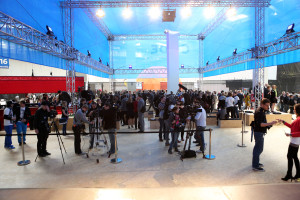Innovation means thinking differently, sharing views and just letting things happen
It may be a buzz word, but innovation is and always has been a passe-partout, a skeleton key to the door to future success. In the current age of global, digital economies, this has never been more true. Economic and social conditions have undergone such sweeping change in recent years, and so has the way we deal with concepts surrounding innovation.
The concept of innovation has been a constant thread of continuity at GFT throughout its more than 25-year history. The company most recently made its approach to innovation evident with its CODE_n initiative.
Innovation is about more than just coming up with a nice idea. It’s about creativity, courage and endurance – more so than ever. Global competition is intensifying and technology cycles are shortening. This is having a fundamental impact on the demands placed on innovation management. The speed at which new digital business models can be developed is evolving into a key success factor. The specific implications of this have been pulled together under five theories:
1. Innovation requires new thinking and a culture of failure.
To innovate, people have to be tolerant towards the unorthodox and share an ambition to understand the new and use it to their advantage. When people succeed in breaking convention and parting with traditional ways of thinking, they foster opportunities to achieve something that is genuinely new. This may meet with resistance, so one needs the energy to convince others, plus sheer determination. It has to do with not seeing failure as defeat, but rather as a learning experience. And this has never been easier, quicker or more inexpensive than it is today. The best example of this is digital prototyping. Thanks to modern software, things can be tried out, in detail, simply through trial and error, without squandering countless sums of money on redeveloped halfway-house solutions.
2. It’s about keeping the best from the past and transposing it into the new context.
Even if innovation means renewal, tradition and innovation are not necessarily mutually exclusive. If anything, it is about retaining the best of the tried and trusted and transposing it into the new, predominantly technological, context. It’s about how traditional ideas or solutions are translated into future-ready digital business models. Achieving this takes an honest and exact assessment of one’s own situation, and services and products in the portfolio – and steering well clear of nostalgic sentimentalities.
3. Technological renewal leads to further innovation, thus changing the big picture.
Innovations are often ingenious redevelopments of technical enhancements already available on the market. As a result, technical innovations can set real waves of innovation in motion. Ultimately, they play a fundamental role at every stage of the digital value chain and can be game-changing for entire industries. The ability of mobile end devices to penetrate our personal and professional lives is a prime example of how one technology can change the entire communication culture within a very short timeframe.
4. Co-innovation refines nebulous ideas into novel, digital business models.
One-dimensional thinking is as foreign to the very nature of innovation as unwavering immovability. Innovation is more about allowing ideas to flow without restriction. The trick is to funnel these until a usable product emerges. Accordingly, GFT pursues principles of open innovation and co-innovation. We actively involve our customers in the innovation process. This results in solutions that inspire, solutions that people can immediately identify with. An important spin-off of this is that as more and more people become advocates of an idea, the more an innovation has the potential to spread out and become marketable.
5. Employees are sources of inspiration, drivers of innovation and multipliers in one.
When searching for new inspiration, companies still tend to forget that they themselves have vast internal reserves of knowledge and ideas: their own employees. The more multifaceted the human resources, the more potential a firm has to find a bright-spark idea at exactly the right moment – assuming the business is willing to involve staff in the innovation process. Integrated into processes in the right way, these people can become veritable incubators of innovation. In parallel to this, the expansion of social networks has resulted in more and more merging of personal and professional environments, with staff becoming important and credible multipliers – ideally conveying the right messages.






Write a comment